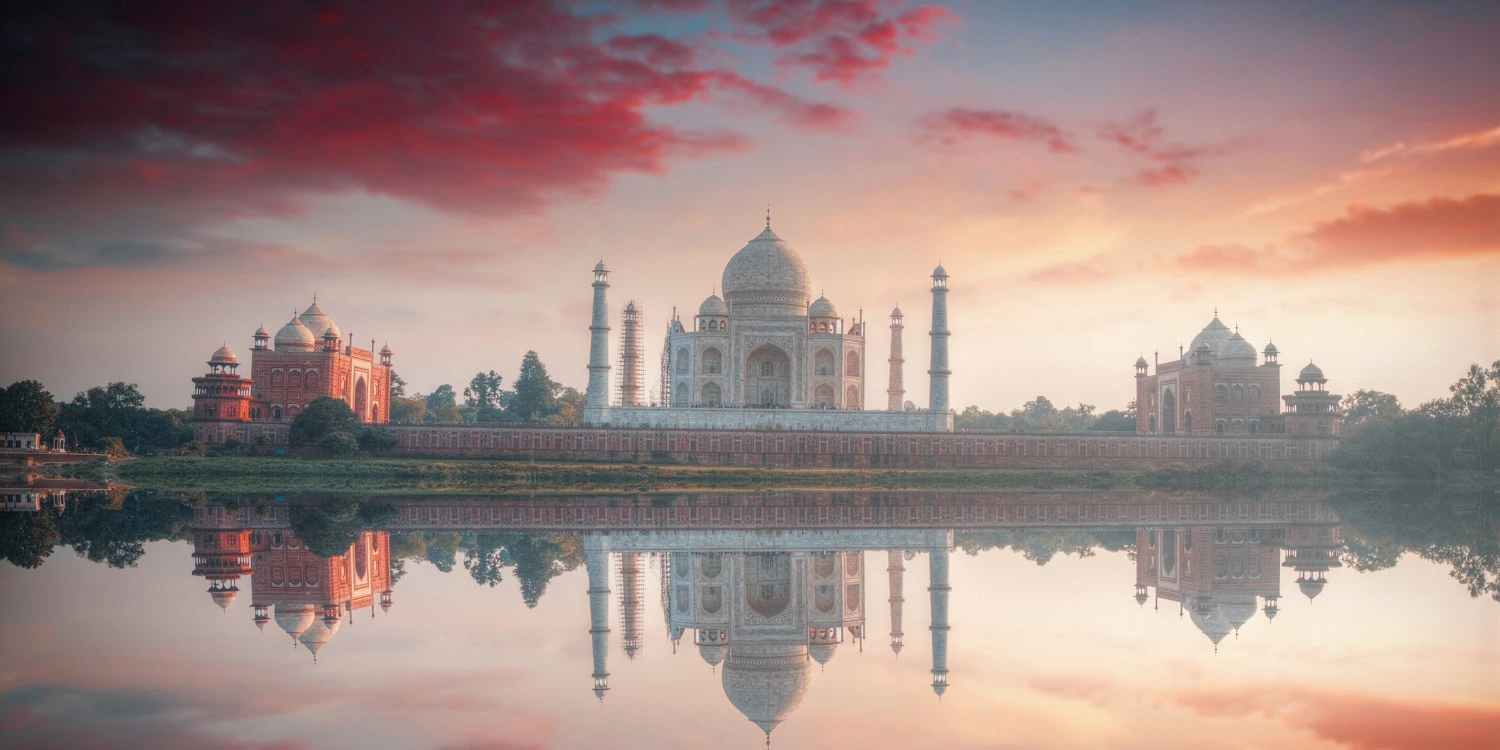The Taj Mahal, an exquisite ivory-white marble mausoleum, stands as an iconic symbol of love and architectural brilliance. Nestled on the banks of the Yamuna River in Agra, India, this magnificent structure is renowned globally for its beauty and historical significance. In this article, we embark on a journey through the history, architecture, and enduring allure of the Taj Mahal.
History and Legacy
Commissioned by the Mughal Emperor Shah Jahan in memory of his beloved wife Mumtaz Mahal, the Taj Mahal is a poignant declaration of love. Construction began in 1632 and took over two decades to complete. The monument also houses the tombs of both Shah Jahan and Mumtaz Mahal.
The Taj Mahal’s history is rich with tales of love and heartache. Legend has it that Shah Jahan’s grief over Mumtaz Mahal’s death was so profound that his hair turned grey overnight. To honor her memory, he spared no expense in creating a mausoleum that would stand as a lasting testament to their love.
Architectural Marvel
The Taj Mahal is a masterpiece of Mughal architecture, blending elements from Persian, Indian, and Islamic styles. Its symmetrical design is a marvel of precision and balance, with intricate calligraphy, stunning floral motifs, and precious gemstone inlays adorning the white marble façade.
The central dome, with its graceful lotus finial, is an iconic feature of the monument. It represents the celestial realm and signifies the eternal nature of love. The four minarets surrounding the Taj Mahal are ingeniously designed to lean slightly outward to prevent them from collapsing onto the main structure in the event of an earthquake.
Influence and Inspiration
The Taj Mahal’s influence extends far beyond its physical presence. It has inspired countless poets, writers, artists, and travelers from around the world. Its timeless beauty has been the subject of literature, music, and films, capturing the imagination of generations.
Architecturally, the Taj Mahal has influenced the design of buildings and monuments worldwide. Its harmonious proportions and intricate detailing continue to be a source of inspiration for architects and designers.
Preservation and Recognition
Recognizing its cultural and historical significance, the Taj Mahal was designated as a UNESCO World Heritage Site in 1983. Over the years, various preservation efforts have been undertaken to protect this architectural gem from environmental and structural threats.
Visiting the Taj Mahal
Each year, millions of visitors from across the globe make a pilgrimage to the Taj Mahal. The best time to visit is during the early morning or late afternoon when the marble takes on different hues in the changing sunlight.
As you approach the monument, you’ll pass through a beautiful garden with reflecting pools, enhancing the sense of serenity and grandeur. Inside, you’ll find the tombs of Shah Jahan and Mumtaz Mahal, beautifully adorned with intricate inlay work.
Taj Mahal Tour FAQs: Everything You Need to Know with Vacation Trip India
The Taj Mahal, a UNESCO World Heritage Site, is a living testament to love and a shining jewel in India’s architectural crown. As you plan your visit to this iconic monument with Vacation Trip India, you might have several questions in mind. This article aims to answer the most frequently asked questions about a Taj Mahal tour.
1. What Is the Taj Mahal, and Where Is It Located?
The Taj Mahal is a breathtaking white marble mausoleum located in Agra, Uttar Pradesh, India. It was built by Emperor Shah Jahan in memory of his beloved wife Mumtaz Mahal and is known for its stunning architecture and historical significance.
2. How Can I Book a Taj Mahal Tour with Vacation Trip India?
Booking a Taj Mahal tour with Vacation Trip India is simple. You can visit their website or contact their customer service to explore tour packages, check availability, and make your reservation.
3. What Are the Different Taj Mahal Tour Packages Available?
Vacation Trip India offers a variety of Taj Mahal tour packages, including same-day tours, multi-day tours, sunrise tours, and customized options to suit your preferences and schedule.
4. How Do I Reach the Taj Mahal?
Agra is well-connected by road, rail, and air. The nearest airport is Agra’s Kheria Airport, while the Agra Cantonment Railway Station serves as a major railhead. You can also reach Agra by road from Delhi, which is approximately 200 kilometers away.
5. What Should I Wear During My Visit to the Taj Mahal?
It’s advisable to dress modestly and respectfully when visiting the Taj Mahal, as it is a place of historical and cultural significance. Avoid wearing sleeveless tops, short skirts, or revealing clothing. Comfortable footwear is recommended for exploring the site.
6. Are There Any Entry Fees to the Taj Mahal?
Yes, there are entry fees to visit the Taj Mahal, which vary for domestic and international tourists. Vacation Trip India typically includes these fees in their tour packages, so be sure to check the details when booking.
7. What Are the Best Times to Visit the Taj Mahal?
The Taj Mahal is open from sunrise to sunset, but the best times to visit are during sunrise and sunset when the monument’s white marble takes on different shades. These times also offer cooler temperatures and less crowded conditions.
8. Is There a Dress Code for Visiting the Taj Mahal?
While there isn’t a strict dress code, it’s advisable to dress modestly and respectfully. Avoid clothing that is too revealing or disrespectful to the cultural and historical significance of the site.
9. Can I Take Photos Inside the Taj Mahal?
Photography is allowed inside the Taj Mahal, but there are restrictions on using tripods and drones. It’s essential to be respectful of the monument and other visitors while taking photos.
10. Are Guided Tours Available at the Taj Mahal?
Yes, guided tours are available at the Taj Mahal. Vacation Trip India often includes experienced guides in their tour packages to provide you with in-depth insights into the history, architecture, and stories behind this remarkable monument.
Conclusion
The Taj Mahal is more than just a monument; it’s a testament to the enduring power of love and the remarkable achievements of human craftsmanship. It stands as a symbol of India’s rich history and cultural heritage, drawing visitors from all corners of the world. A visit to the Taj Mahal is not just a journey through time but a profound experience of beauty, history, and romance.





